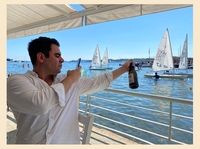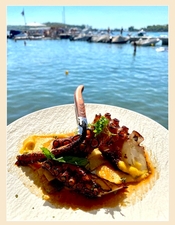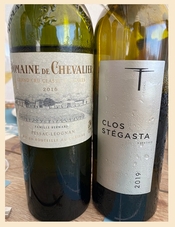Summer 2021 has been somewhat easier for travel despite the threat of new COVID-19 variants Delta and Lambda (and who knows which others to come). As more people get vaccinated, and governments require proof, one can feel a bit safer, or at least hope so. As I traveled through Greece this summer, social distancing and mask wearing indoors are required. My trip this year included great experiences on the islands of Cephalonia and Zakinthos, but also in Vouliagmeni, considered the “Athenian Riviera.” Located about 30 minutes away by car from the southern Athens (about 40 from central Athens), the restaurant Blue Fish, which opened five years ago, has earned a well-deserved “Travelers’ Choice” category in
Trip Advisor.

I dined there in June this year but recap my first-ever discovery of this Aegean seaside restaurant last year, thanks to the hard-working Yiannis Karakasis MW, who invited me to join family and friends for lunch. One of the most active MWs I know, he just published a book on Santorini wine and last year organized the first-ever competition of 50 Great Greek Wines (50GGW), which has become a reference for many wine lists in the country, based on a panel of independent judges.
The easy-going lunch began with a swim in the sea along the restaurant’s exclusive private beach area: quite a plus as nearby public beaches were packed, and last year no one had been yet vaccinated.
So close to the water, a windier day would have easily gotten our feet wet. But the air was calm. Between bites we went stepped down a small ladder into the sea. In addition to a superb choice of seafood and fish, the restaurant has a great wine list – many excellent Greek wines and top international brands – thanks to Yiannis, who consults for other fine restaurants as well.
Restaurant director and head chef George Economidis crafted dishes to pair with many wines that Yiannis brought. And what a friendly, efficient, and educated staff, including a sommelier who recently earned her WSET diploma.
An inspired chef, George had worked for several years on what has become the rather posh island of Paros, in the Cyclades. As for the wines, we started with two from the island of Serifos, both interesting and tasty.
Paired with oysters topped in a savory Daikon Oroshi (grated daikon radish) and chilli sauce, the first wine made from an indigenous grape from the island called Serifiotiko had a Marzipan-like, medium-bodied palate, marked by medium length and a salty finish that echoed the oyster flavors. At 14% alcohol, the grape must have high natural acidity, as it was not heavy, and reminded me of warmer climate Grüner Veltliner, with that salty aspect and rather streamlined palate. Yiannis also brought an Orange Wine version by the same producer, exuding spicy curry and chickpea aromas that struck me more than the “conventional” wine. It even looked orange, given six months skin contact, but I felt that the finish dried out and came up short, making me wonder whether shorter skin contact would have been better.
Just before cracking open the Champagne – the J-M Sélèque Solessence Brut Nature mainly from 2012 vintage grapes blending Chardonnay (50%), Pinot Meunier (40%) and Pinot Noir (10%) – we took another plunge in the sea. The day was warm and sunny so the sea plunging option was taken even if the awning over our table kept us in the shade as temperatures reached about 90 degrees Fahrenheit: very hot, but not as intense as the heat this year that has been associated with so many terrible fires in Greece and other parts of southern Europe and Turkey. With zero residual sugar, the Champagne conveyed the richness of the 2012 vintage. It had fine bead and verve. We loved it with the Tuna Tartar and Seafood Ceviche.

Yiannis then opened the best dry white I can recall trying from Cyprus, a limited-edition wine from Paphos by the Vouni Panayias Winery made from the Morokanela grape. This medium-bodied wine evoked sweet herbs, fennel, and fresh lemon peel, with a palate dense and fresh. While still enjoying the superb Ceviche and Tuna Tartar, the grilled octopus arrived, and what a great plate! Served over braised leek and the classic fava spread made from yellow split peas (famous on Santorini), the octopus proved to be among the thickest and most tender I have experienced in my many years visiting Greece, and readers who go here must order it.
The octopus and a plate of just-caught sea bass, accompanied by shiitake and oyster mushrooms, proved to be a fine match for the concentration and depth of two superb dry whites, which showed the extent to which Assyrtiko can meet the quality of top Bordeaux white.
The T-OINOS Clos Stegasta Assyrtiko 2019 stole the show. A celebrated Assyrtiko wine from the island of Tinos, it exuded cool white stone fruit, grapefruit rind, and later, orange blossom. The rather full-bodied palate exuded refined textural finesse and subtle density, leading to a long finish marked by wet stone freshness. Furthermore, the wine gave me a good idea of the potential aging power of Assyrtiko from a great vineyard. Indeed, Yiannis had opened it the day before, yet it tasted as fresh as a daisy. As you can read from my visit there in 2019 – in
wine-chronicles.com – it comes from a unique vineyard, planted at 11,000 vines per hectare. “There is no other wine in Greece with such a thick planting density,” Yiannis remarked.
After having visited the estate two years ago, where I enjoyed tasting a vertical selection of this wine from multiple vintages, the 2019 may come across as a bit warmer than usual and clocks in at 13.5% alcohol (then again, the 2019 vintage at Sigalas on Santorini is a full degree higher). In any case, the alcohol was hardly an issue as the wine’s tightly wound energy for a ripe vintage is unmistakable. Sadly, hail had reduced production to about one half, so only 4,500 bottles exist in this vintage.

I brought along a Domaine de Chevalier Pessac-Léognan Blanc 2016. It sang as nicely as expected, pairing well with the sea bass and lobster from a seafood medley that had been served as well in the meantime. 2016 was on the warmer vintage register for Bordeaux whites, but this estate’s cooler terroir proved a match. Sealed with a Diam 30 cork, the wine retains freshness better than ever. Indeed, owner Olivier Bernard has been using the Diam30 since the 2015 vintage, which I had tasted for an article in
Decanter. It took time to open up (how often must we emphasize that great dry whites need air?), whereupon it displayed fine pear aromas along with ripe apricot and Key Lime pie. The comparison with the Assyrtiko proved to be on equal terms: two excellent dry whites.
Far from done, chef George brought out a fish called Fargi, derived from the red snapper family, also called Lethrini: typical of Greek waters. We enjoyed the “crown” infused with fresh lemon juice, choosing between cheeks (magouli) or head with eyes. I opted for the tender cheeks. The main body of the fish was the best, with a most tender texture. A series of colorful side dishes (beet and carrot purées to quinoa, and potato and celery root purées) made this a feast for the eyes and for the appetite.
However, as the Germans aptly say: Everything has an end, but only a sausage has two (
Alles hat ein Ende. Nur die Wurst hat zwei), the Merry-Go-Round had to end. But if ever in Athens, book a taxi and give Blue Fish a try.